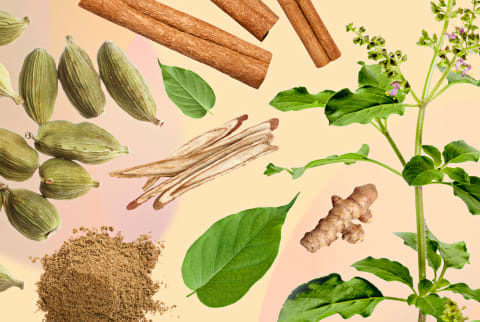The Uses, Benefits & Side Effects Of 9 Ayurvedic Herbs & Spices

Sahara Rose is an author currently living in Los Angeles, California.


In Ayurveda, spices and herbs are considered powerful plant medicines, and there are a variety available to address many underlying issues. The best herbs and spices are organic and obtained straight from a reliable source.
Brewing teas is a great way to consume your daily dose of Ayurvedic herbs and spices, and they can be healthier alternatives to caffeinated black tea or coffee. You can also toss these plant medicines into food. Here are nine herbs and spices that are highly prized in Ayurveda and a little teaser on the benefits and applications of each:
Gymnema sylvestre
Gymnema leaf, or Gymnema sylvestre, is a shrub that originates from the forests of India, Africa, and Australia.
In Ayurveda, we use its medicinal leaves to help reduce sugar cravings, lower blood sugar levels, aid in weight loss, and reduce inflammation. Clinical trials are now looking into using Gymnema sylvestre as a diabetes medication1 due to its hypoglycemic properties.
How to use it:
You can find Gymnema sylvestre in supplement capsule form or consume its dried leaves in a tea. Boil the leaves for 5 minutes, and then let it sit for 10 to 15 before sipping.
Potential side effects:
Side effects such as headache, nausea, lightheadedness, shakiness, and dizziness can occur if you mix Gymnema sylvestre with other herbs or medicines aimed at lowering blood sugar levels, as it can cause your blood sugar to drop too much.
Who shouldn't use it:
Anyone who is taking aspirin or St. John's wort or is allergic to milkweed.
Cinnamon
Cinnamon is native to Ancient Egypt, created from cutting the stems of the cinnamon tree and extracting the inner bark.
It's an anti-inflammatory that's a great source of antioxidants, too. Cinnamon also helps to lower blood sugar and curb cravings2. Finally, cinnamon has been found to lower cholesterol3. Its spicy kick can even help prevent bad breath, hence why some toothpastes feature it as a star ingredient.
How to use it:
This easily accessible ingredient can be found at virtually any supermarket and consumed in various ways. I like adding it to warm beverages and sprinkling it on fruit.
Potential side effects:
Side effects can occur if you consume too much cinnamon. Cassia cinnamon, in particular, which contains the compound coumarin4, could potentially contribute to liver damage, mouth sores, and breathing problems. For this reason, it's wise to cap your cinnamon intake to 1 teaspoon a day.
Who shouldn't use it:
You should avoid taking cinnamon5 with medications for diabetes, heart disease, and liver disease as it can enhance their side effects.
Fenugreek
Fenugreek is an herb that is native to the Mediterranean region, southern Europe, and western Asia.
Fenugreek seeds have long been used in Ayurveda to fight against skin conditions, enhance breast milk production, and boost sexual function in men, as well as control appetite, cholesterol levels, heartburn, and inflammation.
How to use it:
The best way to consume fenugreek is in tea form by lightly crushing the seeds and mixing them with hot water. It can also be used to season many dishes such as sauces, curries, vegetables dishes, and soups.
Potential side effects:
When taken in large amounts, fenugreek can cause possible side effects such as diarrhea, stomach upset, bloating, gas, dizziness, and headaches.
Who shouldn't use it:
Pregnant women should not consume fenugreek. Interestingly enough, those who are allergic to chickpeas might also be allergic to fenugreek and should avoid it.
Holy basil (tulsi)
Holy basil (tulsi) is a green leafy plant native to Southeast Asia. It offers many potential medicinal benefits for a variety of mental and physical issues. Multiple6 studies7 have highlighted its antidepressant and anti-anxiety properties, and it may also help lower blood sugar8, alleviate joint pain9, and soothe the stomach6.
How to use it:
While you can consume tulsi in food and supplements, I prefer to turn its leaves, flowers, or dried leaf powder into a tea.
Potential side effects:
While tulsi is meant to be soothing, some may find that it makes them feel wired, stressed, or overly jittery.
Who shouldn't use it:
It is best to avoid tulsi if you are lactating, pregnant, or trying to become pregnant.
Triphala
Triphala is an Ayurvedic formula consisting of three fruits that originate from India: Amalaki, Bibhitaki, and Haritaki.
The trio is used to help promote better digestion and regular bowel movements10. It's often prized by those who suffer from constipation. And unlike other laxatives, triphala does not force your muscles to loosen up to create a bowel movement, and it can be used on a daily basis11. Additionally, it is a natural antioxidant.
How to use it:
The best way to consume triphala is in tea form using its powder, but it can also be taken in tablet or liquid extract form.
Potential side effects:
Some side effects of this herb include stomach upset, cramps, and diarrhea. However, these symptoms can be eased by lowering the dosage.
Who shouldn't use it:
Triphala may have a negative interaction with medication for diabetes and high blood pressure.
Turmeric
Turmeric is the golden spice that has been used in Ayurveda for thousands of years and is now gaining popularity in the modern world.
Its main component, curcumin, can help reduce inflammation12, promote immunity13, protect heart health14, and even support the brain15 as we age.
How to use it:
The best way to consume turmeric is to combine it with black pepper, which enhances its absorption in the body. I like adding it to food or taking it in tea form.
Potential side effects:
Some mild side effects of this spice include stomach upset, nausea, dizziness, and diarrhea.
Who shouldn't use it:
Those with gallstones, a bile duct obstruction, or gallbladder disease will want to stay away from turmeric.
Licorice root
Licorice root is widely used as a sweetener in many foods and beverages, but despite its pleasant taste, it also offers some health benefits.
For starters, it can help soothe the stomach16, reduce stress, and even support skin health in some cases.
How to use it:
Licorice root can be taken in many forms such as liquid extract, powder, tea, and DGL (licorice with glycyrrhizin removed for stomach issues). If you are just taking it to enhance your health and well-being, you can drink licorice tea or add licorice extract or powder to sweeten any food.
Potential side effects:
A steady hand is important here: If you consume too much of this herb, it can lead to muscle weakness, fluid retention, metabolism abnormalities, high blood pressure, swelling, and heartbeat irregularity, according to research17.
Who shouldn't use it:
Due to its potential side effects, those who have high blood pressure, kidney disease, or heart disease will want to steer clear of licorice root. Pregnant and breastfeeding women should also avoid it.
Cumin
Cumin is a spice made by crushing the seeds of the Cuminum Cyminum plant, and it's used to flavor many dishes, mainly in its native regions of the Mediterranean and Southwest Asia.
Research has found that cumin can support healthy digestion18 and helps improve blood sugar control and cholesterol19.
How to use it:
If you intend on taking cumin regularly for your general improved health and well-being, it is best to just use small amounts to season your food.
Potential side effects:
Although side effects rarely occur, taking high doses of cumin could lead to fertility difficulties in men and could induce pregnancy loss in women.
Who shouldn't use it:
Those on medications for diabetes should not take cumin, as it might cause blood sugar levels to dip too low.
Cardamom
Cardamom is a widely used spice with a slightly sweet taste. The seeds, oils, and extracts of cardamom have long been prized in Ayurveda due to their ability to help lower blood pressure20, protect against inflammation and oxidative stress21, and relieve digestive issues.
How to use it:
The best way to consume cardamom is to add it to foods or beverages; you can brew it with your tea or sprinkle it in your yogurt or oatmeal for breakfast.
Potential side effects:
Cardamom appears to be safe to take in low doses and hasn't been associated with any major side effects.
These are just some of the herbs and spices you can add to your daily diet to take that extra step toward improving your health and well-being.

Sahara Rose is an author currently living in Los Angeles, California. She authored two books on ayurveda Eat Feel Fresh: A Plant-Based Ayurvedic Cookbook and Idiot's Guide to Ayurveda, both with foreword by Dr. Deepak Chopra. She has been featured in Vogue, Forbes, Yoga Journal, Huffington Post, and NBC News. She was also the featured nutrition speaker at Michelle Obama’s Let’s Move! event at Harvard Medical School.
21 Sources
- https://www.ncbi.nlm.nih.gov/pubmed/27834124
- https://pubmed.ncbi.nlm.nih.gov/21538147/
- https://www.ncbi.nlm.nih.gov/pubmed/14633804
- https://www.ncbi.nlm.nih.gov/pubmed/20024932
- https://www.hindawi.com/journals/ecam/2014/642942/
- https://www.ncbi.nlm.nih.gov/pmc/articles/PMC5376420/
- https://www.ncbi.nlm.nih.gov/pmc/articles/PMC4296439/
- https://pubmed.ncbi.nlm.nih.gov/8880292/
- https://www.ncbi.nlm.nih.gov/pmc/articles/PMC5041386/
- https://www.ncbi.nlm.nih.gov/pmc/articles/PMC5567597/
- https://www.ncbi.nlm.nih.gov/pmc/articles/PMC6052535/
- https://lpi.oregonstate.edu/mic/dietary-factors/phytochemicals/curcumin
- https://pubmed.ncbi.nlm.nih.gov/19594223/
- https://pubmed.ncbi.nlm.nih.gov/19233493/
- https://www.ncbi.nlm.nih.gov/pmc/articles/PMC2781139/
- https://www.ncbi.nlm.nih.gov/pmc/articles/PMC6065514/
- https://www.ncbi.nlm.nih.gov/pmc/articles/PMC3498851/
- https://www.ncbi.nlm.nih.gov/pmc/articles/PMC3210012/
- https://www.ncbi.nlm.nih.gov/pmc/articles/PMC4039583/
- https://pubmed.ncbi.nlm.nih.gov/20361714/
- https://pubmed.ncbi.nlm.nih.gov/28480505/
